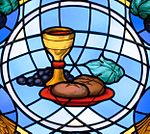| Part of a series on the |
| Eucharist |
|---|
 |
Consubstantiation is a Christian theological doctrine that (like transubstantiation) describes the real presence of Christ in the Eucharist. It holds that during the sacrament, the substance of the body and blood of Christ are present alongside the substance of the bread and wine, which remain present. It was part of the doctrines of Lollardy,[1] and considered a heresy by the Roman Catholic Church.[2] It was later championed by Edward Pusey of the Oxford Movement, and is therefore held by many high church Anglicans.[3][4] The Irvingian Churches (such as the New Apostolic Church) adhere to consubstantiation as the explanation of the real presence of Christ in the Eucharist.[5]
- ^ Cite error: The named reference
Walker2013was invoked but never defined (see the help page). - ^ "Consubstantiation". NewAdvent.org.
- ^ Cite error: The named reference
Murphy2007was invoked but never defined (see the help page). - ^ Cite error: The named reference
Vogan1871was invoked but never defined (see the help page). - ^ "The Catechism of the New Apostolic Church: 8.2.12 The real presence of the body and blood of Christ in Holy Communion". New Apostolic Church. 18 December 2020.
Rather, the substance of Christ's body and blood is joined to them (consubstantiation).